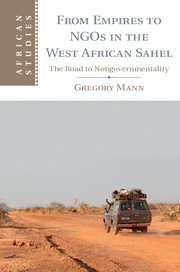Book contents
- Frontmatter
- Contents
- List of Maps and Figures
- Acknowledgments
- Maps
- Note on Terminology
- Introduction
- Part I
- Part II
- Introduction to Part II: Sahelian Migrations and State Thought
- 3 “French” Muslims in Sudan
- 4 Well-Known Strangers: How West Africans Became Foreigners in Postimperial France
- Part III
- Works Cited
- Index
- References
3 - “French” Muslims in Sudan
Published online by Cambridge University Press: 05 January 2015
- Frontmatter
- Contents
- List of Maps and Figures
- Acknowledgments
- Maps
- Note on Terminology
- Introduction
- Part I
- Part II
- Introduction to Part II: Sahelian Migrations and State Thought
- 3 “French” Muslims in Sudan
- 4 Well-Known Strangers: How West Africans Became Foreigners in Postimperial France
- Part III
- Works Cited
- Index
- References
Summary
The West African presence in the Nilotic Sudan is old, deep, and dynamic, and the West–East Sahelian axis long predates the arrival of European empires. But if they did not generate that axis of migration, the presence of those empires was the precondition for its transformation. In the twentieth century, pilgrimage routes, the phenomenon of the pilgrimage itself, and colonial awareness of it concealed new forms of migration from the West. In this period, when one looks at pilgrims, one should see migrants. Such a perspective requires adjusting our vision in two ways. First, social scientists have produced excellent studies of the phenomenon of the overland pilgrimage and pilgrim communities in Sudan and in Chad. But whether these are framed as studies of migration as such or emphasize instead the religious and phenomenological aspects of the hajj, they do not draw out themes of state practices and logics or of postcolonial politics. Rather, they naturalize the frame of government itself. Second, the political entities by which pilgrims and migrants were identified – and by which they on occasion identified themselves – underwent rapid changes during their long, and sometimes endless pilgrimages, rendering their own political affiliations obscure, or at least multiple. For long years, that did not matter at all. Then suddenly, for a few years in the mid-1950s, it mattered a great deal.
- Type
- Chapter
- Information
- From Empires to NGOs in the West African SahelThe Road to Nongovernmentality, pp. 93 - 119Publisher: Cambridge University PressPrint publication year: 2014

